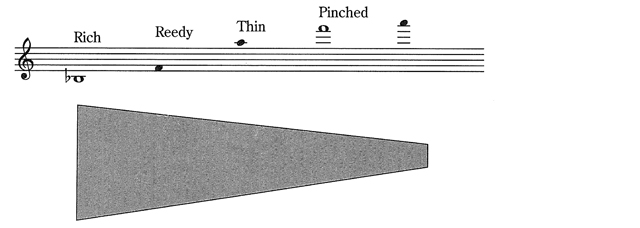Oboe and English Horn
IT: oboe – FR: hautbois – GER: Oboe, Hoboe
Properties
The oboe is a wooden double-reed instrument with a conical bore. Two curved blades of cane are bound around a staple, which is inserted in the upper end of the oboe to form the mouthpiece. The reeds vibrating together at their elliptical opening produce the tone. Slight differences in moisture or temperature or imperfections in the reed can have an enormous effect on the tone. The oboe is overblown at the octave.
Range and Natural Dynamics
FIGURE 3.7 Oboe range
The compass is roughly two and a half octaves upward from b-flat below c1. It is very difficult to play the lowest notes quietly and delicately.
Tone Quality
The middle register is reedy and characteristic. The oboe generally penetrates through other instrumental textures, so it makes an excellent solo voice. A moderate amount of vibrato is a standard element in the oboe sound. Because of its striking tone color, the oboe should be used carefully.
Technical Abilities
The oboe is an extremely agile instrument, capable of performing complex passages. It requires considerable breath support in the lungs because the small quantity of air that moves through the instrument must be carefully controlled. Beginning a phrase on a very low note is quite difficult. Rests should occur frequently in oboe parts to allow the player to take in fresh oxygen. Fast single-tonguing is possible, but double-tonguing is very difficult. All trills are possible, as are tremolos between notes up to about a perfect fourth apart, on professional quality instruments. There are some limitations in this area on student models.
Musical Example
FIGURE 3.8 Oboe line: Schubert, Unfinished Symphony, Andante, measures 84-92
Refer also to the Overture to Der Freischiitz, by C. M. von Weber in the Excerpts in Score section.
English Horn
IT: corno inglese – FR.: cor anglais – GER: englisches Horn
Range and Dynamics
FIGURE 3.9 English horn range
Transposition
The English horn is pitched in F and must be transposed up a perfect fifth in the treble clef. The compass is two and a half octaves upwards from the b below c1. Oboe and English horn share a similar dynamic curve, and common principles govern their use. The lowest tones on the English horn are produced much more easily and gracefully than on the oboe. It has a more delicate, rounded sound throughout its range and blends more readily with other instruments, but it is somewhat less agile. The term “English” may be a mistranslation of the French word “angle” because the instrument was initially curved and is not of English origin.
Less common members of the oboe family are the oboe d’amore, the baritone oboe, and the heckelphone.
Musical Example
FIGURE 3.10 English horn line: Dvorak, Symphony No.9, Largo, measures 7-10




